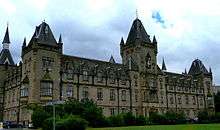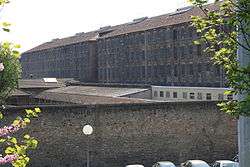Andrée Borrel
Andrée Raymonde Borrel (18 November 1919 – 6 July 1944) was a French woman who served in the French Resistance and as an agent for Britain's clandestine Special Operations Executive in World War II.[1][2][3] The purpose of SOE was to conduct espionage, sabotage, and reconnaissance in occupied Europe against the Axis powers, especially Nazi Germany. SOE agents allied themselves with resistance groups and supplied them with weapons and equipment parachuted in from England.
Andrée Borrel | |
|---|---|
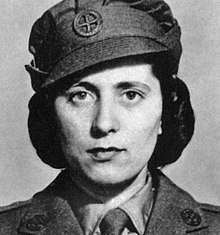 In FANY uniform after joining SOE (1942). | |
| Nickname(s) | Monique (SOE codename for the Whitebeam operation and subsequent work in France), Denise Urbain (alias while working as an SOE agent in France) |
| Born | 18 November 1919 Bécon-les-Bruyères, France |
| Died | 6 July 1944 (aged 24) Natzweiler-Struthof, France |
| Allegiance | France, Britain |
| Service/ | French Resistance Special Operations Executive |
| Years of service | 1942–1944 (SOE) |
| Rank | Lieutenant (nominally for FANY while actually an SOE agent) |
| Unit | Prosper (SOE) |
| Battles/wars | Second World War |
| Awards | Croix de Guerre Médaille de la Résistance KCBC |
Borrel was a member of the SOE's Prosper circuit in occupied France where she worked as a courier until arrested by the Gestapo.[4] She was subsequently executed at the Natzweiler-Struthof concentration camp.[4]
Early life
Andrée Borrel was born into a working-class family in Bécon-les-Bruyères, a north-western suburb of Paris, France.[5] She was good at sports, while her older sister (Léone), described Borrel as a tom-boy, who had the strength, endurance and interests of boys, whose favourite pastimes were bicycling in the countryside, hiking and climbing.[6]
Her father (Louis) died when she was 11, and to help support her family she left school at 14 to work for a dress designer.[5] When she was 16 her family moved to Aristide Briand, Paris, where she spend two years as a shop assistant in Boulangerie Pajo, a bakery, after which she worked at the Bazar d'Amsterdam as a shop assistant which allowed her to have Sundays off so she could enjoy her passion for cycling.[7] In October 1939, her mother (Eugenie) was advised to move to a warmer climate for her health, so took Andrée and her sister to Toulon on the Mediterranean coast where they had family friends.[8]
Not long before World War II broke out, Borrel's socialist sympathies led her to travel to Spain to help the Republican government in its fight against the Nazi-backed fascists in Spain, but found that the war had all but been lost and returned to France.[9]
War work in Europe (1939–42)

When World War II broke out Borrel went to work with the Red Cross to volunteer her services.[10][8] She enrolled in a crash course in nursing that she completed on 20 January 1940, which qualified her to serve as a nurse in the Association des Dames Françaises.[10][8] First at Hôpital Compliméntaire in Nîmes in early February, though she was sent back 15 days later following a decree that nurses under the age of 21 were not allowed to serve in hospitals.[8] This decree was revoked a few days later and she was sent to the Hôpital de Beaucaire in Beaucaire.[8] One of her co-workers there was Lieutenant Maurice Dufour, and when the hospital was closed they were both sent to Hôpital Compliméntaire.[10] Towards the end of July that hospital was to be closed and, at the request of Dufour, Borrel was allowed to resign from this quasi-military institution, after which she immediately went to work for the underground organisation Dufour was involved in.[10][11]
At the beginning of August 1941, Borrel and Dufour established the Villa Rene-Therese in Canet-plage, on the Mediterranean coast just outside Perpignan near the Spanish border, which became the last safe house (before the hard and dangerous route over the Pyrénées) in the "Pat O'Leary Line", an escape network established by Albert Guérisse (supported by MI9), which helped British airmen shot down over France, SOE agents, Jews and others escape German controlled France.[10][12] This villa proved too small and at the beginning of October they rented the Villa Anita.[13] Towards the end of December the escape network had been compromised and closed down, with Borrel and Dufour finding other accommodation until eventually escaping over the Pyrénées in mid-February to Spain and from there to Portugal, where they flew to England (Dufour on 29 March 1942 and Borrel on 24 April 1942).[14][15]
Arrival in England
Soon after landing in England, like all arrivals from the Continent, she was taken to the Royal Patriotic School, the MI5 security clearance centre.[16][17] Their report concluded:
Mlle Borrel's story seems perfectly straightforward. It is corroborated by Dufour who, on arriving in England, vouched for her. She is an excellent type of country girl, who has intelligence and seems a keen patriot. From a security point of view, I can find nothing against Mlle Borrel and recommend her release to the FFF.[18][16]
Borrel had wanted to join the Free French Forces but they were not enthusiastic about French citizens who had worked with the British (who were deeply involved in the escape network Borrel had been working with), and were not interested in Borrel as she refused to divulge information about all her prior activities.[19] Borrel was subsequently approached by the Special Operations Executive and joined it on 15 May 1942.[20]
Special Operations Executive (1942–44)
SOE training
Borrel seemed like just the type of woman SOE needed for a field agent.[20] Her SOE interviewer commented:
Since arriving in London, she attempted to join the Corps Feminin of the Free French movement but they have made it a condition that she should give them all the intelligence concerning the organization for which she was working in France. This she refuses to do and apparently they refuse to employ her unless she does. I think that she would make an excellent addition to our own Corps Feminin and it should not be difficult to get her… She said that she was perfectly willing to let us have the information she refuses to give to the Free French.[20]
Borrel undertook training with SOE to become a field agent with their F Section while officially an ensign in the First Aid Nursing Yeomanry (FANY).[21] Upon the successful completion of her training, she was promoted to lieutenant.[21] The commandant's report contained the following appraisal:
Of sound intelligence, if lacking somewhat in imagination. She has little organising ability and will do her best work under definite instructions. She is thoroughly tough and self-reliant with no nerves. Has plenty of common sense and is well able to look after herself in any circumstances and she is absolutely reliable. Has lost her attitude of over-confidence and has benefited enormously from the course and developed a thoroughly level headed approach towards problems. A very pleasant personality and she should eventually develop into a first class agent.[22]
Parachuted into France
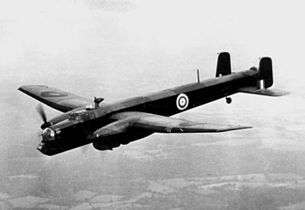
On the night of 24 September 1942, Borrel ("Monique") and Lise de Baissac ("Odile") became the first female SOE agents to be parachuted into occupied France,[23][24][25] as part of operation "Whitebeam" to set up resistance networks in Paris and Northern France (circuits and sub-circuits). They were flown in from RAF Tempsford.[24] Borrel dropped first, while they both landed in a field near the village of Mer, not far from the Loire River, about 100 kilometres from Paris, and were picked up by members of a local resistance team.[26] Years later Baissac recalled the experience:
As it happens, we went twice. The pilot wouldn't drop us the first time because the lights of the landing field were not quite accurate, so we had to come all the way back, which was very trying. You were squashed in that little place with a parachute on your back and your legs drawn up, and, of course, there was the danger too. Back in England they told us the reception committee had a man missing so they couldn't place the lights for the signal the way they were supposed to. We went back again the next night. We sat on the floor of the airplane [a Whitley bomber], much too tense for conversation, which in any case was not possible because of the noise. I don't remember how long it was until the dispatcher opened the hole, which meant we were arriving. We crept nearer, getting our legs into position. We had drawn straws and luck gave Andrée the first jump. I went immediately after her. You had to jump very quickly, one right after the other, because the plane is going on and you might be dropped very far from each other.[26]
Some Whitley bombers were modified to allow them to reach Poland so SOE agents could be parachuted in.[27] They had to be extensively remodelled with an auxiliary fuel tank in the fuselage to make the 14-hour return flight.[27]
Physician (Prosper) circuit
Because of her intimate knowledge of Paris, it was only natural that Borrel would be sent there to work as a courier for the new "Prosper" circuit run by Francis Suttill (officially named "Physician" but unofficially called "Prosper" after Suttill's codename). Suttill was impressed with Borrel's performance and in the spring of 1943 she was made second in command of the Paris circuit.[28][29] Whilst working in Prosper she took part in a wide range of activities including the creation of circuits in Paris and northern France, sabotage, weapons training, and supervising weapons drops.[28][29][30] In a note to SOE in March 1943, Suttill wrote:
Everyone who has come into contact with her in her work agrees with myself that she is the best of us all. In J…'s absence, she acted as my Lieutenant. Shared every danger. Took part in a December reception committee with myself and some others. Has a perfect understanding of security and an imperturbable calmness. Thank you very much for having sent her to me.[31][32]
Madam Guépin, the wife of George Darling (who ran a resistance group in north-west France), said Borrel "Had a head on her shoulders and a will of iron", and was "utterly loyal and devoted to Prosper [Suttill], as her chief, and to Archambaud [Gilbert Norman]."[33] Norman was the W/T operator.
Arrest and execution
Gestapo raid
On the night of 23/24 June 1943, Borrel was arrested along with several other members of the Prosper circuit by the Gestapo.[34][35] She was interrogated in the Gestapo's Paris headquarters in the Avenue Foch where she exhibited what was later described as a fearless contempt for her captors, maintaining "a silence so disdainful that the Germans did not attempt to break it."[36] While held in the Fresnes Prison she smuggled out notes to her mother written on cigarette paper hidden in lingerie she sent her sister for washing. Most messages were to reassure her mother and request items like a notebook and hairpins, ending with lots of kisses. Others indicated that she had been betrayed by Norman, who was reported to have told her to tell the Germans what they wanted to know.[36][37]
Moved to Germany
On 13 May 1944, Borrel together with three other captured female SOE agents, Vera Leigh, Sonia Olschanezky and Diana Rowden, were moved from Fresnes to the Avenue Foch along with four other women whose names were Yolande Beekman, Madeleine Damerment, Eliane Plewman and Odette Sansom, all of whom were F Section agents.[38] Later that day they were taken to the railway station, and each handcuffed to a guard upon alighting the train.[39] Sansom, in an interview after the war, said:
We were starting on this journey together in fear, but all of us hoping for something above all that we would remain together. We had all had a taste already of what things could be like, none of us did expect for anything very much, we all knew that they could put us to death. I was the only one officially condemned to death. The others were not. But there is always a fugitive ray of hope that some miracle will take place.[40]
When the women arrived in Germany they were put into separate cells in the prison in Karlsruhe (Justizvollzugsanstalt Karlsruhe) – Sansom with a woman who had been in prison for three years because her own daughter (a member of the Hitlerjugend) had denounced her for listening to the BBC, and Jehovah's Witnesses.[41] The agents were treated no differently from other prisoners – markedly better than those in concentration camps – and were given manual work to do, peeling potatoes, sewing, etc., which helped pass the time.[41] Occasionally, through the high bars, they could hear Allied bombers headed for targets within Germany, so on the whole things looked good for them even if there was the possibility of dying in an air raid.[41] The war was unmistakably coming closer to an end and they could reasonably expect to be liberated by the Allies before too long.[41]
Execution at Natzweiler-Struthof
Monument to the Departed in background.

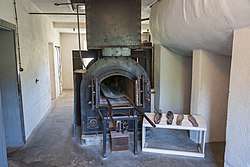
Between five and six in the morning on 6 July 1944, not quite two months after their arrival in Karlsruhe prison, Borrel, Leigh, Olschanezky and Rowden were taken to the reception room, given their personal possessions, and escorted by two Gestapo men 100 kilometres south-west by closed truck to the Natzweiler-Struthof concentration camp in France, where they arrived around three-thirty in the afternoon. The women's arrival was apparently unexpected as was the order by one of the women's escorts that the four women were to be executed immediately.[42][43]
As women were a rarity in the camp their presence immediately attracted attention from both German guards and prisoners. The four women were led through the center of the camp down to the cellblock at the bottom of the camp by SS men and held there until later that night. "One could see from their appearance that they hadn't come from a camp," said a French prisoner. "They seemed young, they were fairly well groomed, their clothes were not rubbish, their hair was brushed, and each had a case in their (sic) hand." [42][42][44]
The four women were initially together but later put into individual cells. Through the windows, which faced those of the infirmary, they managed to communicate with several prisoners, including a Belgian prisoner, Dr Georges Boogaerts, who passed one of the women (whom he later identified as Borrel from a photograph) cigarettes through the window. Borrel threw him a little tobacco pouch containing some money.[45]
Albert Guérisse, a Belgian army physician who had headed the Pat O'Leary escape line in Marseille,[46] recognized Borrel as one of his former helpers.[47] He exchanged a few words with another one of the women, who said she was English (Leigh or Rowden) before she disappeared into the cellblock building. At the post-war trial of the men charged with the execution of the four women, Guérisse stated that he was in the infirmary and had seen the women, one by one, being escorted by SS guards from the cellblock (Zellenbau) to the crematorium a few yards away.[48] He told the court: "I saw the four women going to the crematorium, one after the other. One went, and two or three minutes later another went."[48]
Inside the building housing the crematorium, each woman in turn was told to undress for a medical check and a doctor gave her an injection for what he told one of them was a vaccination against typhus, but was in fact a 10cc dose of phenol which the doctor believed was lethal. When the woman became unconscious after the injection, she was inserted into the crematorium oven. Guérrise said, "The next morning the German prisoner in charge of the crematorium explained to me that each time the door of the oven was opened, the flames came out of the chimney and that meant a body had been put in the oven. I saw the flames four times." The door was locked from the outside during the executions, but it was possible to see the corridor from a small window above the door, so the prisoner in the highest bunk was able to keep up a running commentary on what he saw.[49]
The prisoner Guérisse referred to was Franz Berg, who assisted in the crematorium and had stoked the fire that night before being sent back to the room he shared with two other prisoners before the executions. The door was locked from the outside during the executions, but it was possible to see the corridor from a small window above the door, so the prisoner in the highest bunk was able to keep up a running commentary on what he saw. [49][50] Berg said:
We heard low voices in the next room and then the noise of a body being dragged along the floor, and he whispered to me that he could see people dragging something along the floor which was below his angle of vision through the fanlight.
At the same time that this body was being brought past we heard the noise of heavy breathing and low groaning combined.
…and again we heard the same noises and regular groans as the [next two] insensible women were dragged away.
The fourth, however, resisted in the corridor. I heard her say "Pourquoi?" and I heard a voice as I recognized as the doctor who was in civilian clothes say "Pour typhus". We then heard the noise of a struggle and the muffled cries of the woman. I assumed that someone held a hand over her mouth. I heard the woman being dragged away too. She was groaning louder than the others.
From the noise of the crematorium oven doors which I heard, I can state definitely that in each case the groaning women were placed immediately in the crematorium oven.
When [the officials] had gone, we went to the crematorium oven, opened the door and saw that there were four blackened bodies within. Next morning in the course of my duties I had to clear the ashes out of the crematorium oven. I found a pink woman's stocking garter on the floor near the oven.[51]
More than one witness talked of a struggle when the fourth woman was shoved into the furnace.[52] According to a Polish prisoner named Walter Schultz, the SS medical orderly (Emil Brüttel) told him the following: "When the last woman was halfway in the oven (she had been put in feet first), she had come to her senses and struggled. As there were sufficient men there, they were able to push her into the oven, but not before she had resisted and scratched [Peter] Straub's face." The next day Schultz noticed that the face of the camp executioner (Straub) had been severely scratched.[53]
The camp doctor (Werner Rohde) was executed after the war. Franz Berg was sentenced to five years in prison[54] but received the death penalty in another trial for a different crime and was hanged on the same day as Rohde. The camp commandant (Fritz Hartjenstein) received a life sentence, while Straub was sentenced to 13 years in prison.
Awards and honours
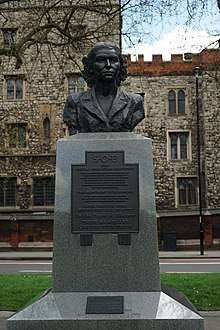
_memorial%2C_Brookwood_Military_Cemetery%2C_5_July_2017.jpg)
Following her arrest by the Gestapo, the SOE produced a citation for an award that stated the following:
This officer was parachuted into France in November 1942 as an assistant to an organiser in the Paris area. She proved herself an able and devoted lieutenant, and was appointed second in command of the organisation. Owing to her cool judgment she was always chosen for the most delicate and dangerous work such as recruiting and arranging rendezvous, and she acted as "cut-out" for her commanding officer.
Lt. Borrel was also given the task of organising parachute dropping operations, and took part in several coups de mains, notably an operation against the Chevilly power station in March 1943. She distinguished herself by her coolness and efficiency and always volunteered for the most dangerous tasks. Her commanding officer paid tribute to her great qualities, describing her as "a perfect lieutenant, an excellent organiser who shares all the dangers".
Lt Borrel was arrested by the Gestapo in July 1943. For her great bravery and devotion to duty during nine months of active underground work in France, it is recommended that she be appointed a Member of the Order of the British Empire (civil division).[55]
Posthumously, France awarded Borrel the Croix de Guerre and the Médaille de la Résistance in recognition of her defence of France, while Britain awarded her the King's Commendation for Brave Conduct (KCBC).[56][57] The concentration camp where she died is a now a French government historical site, where a plaque to Borrel and the three women who died with her is part of the Deportation Memorial on the site. As one of the SOE agents who died for the liberation of her country, Lieutenant Borrel is listed on the "Roll of Honor" on the Valençay SOE Memorial in the town of Valençay, in the Indre department of France. She is also commemorated on the Tempsford Memorial in the village of Tempsford in the county of Bedfordshire in the East of England.[58][59] A later memorial, the SOE Agents Memorial in Lambeth Palace Road (Westminster, London), is dedicated to all SOE agents. She is also commemorated in column 3 of panel 26 of the Brookwood Memorial as one of 3,500 "to whom war denied a known and honoured grave".[60]
In 1985, SOE agent and painter Brian Stonehouse, who saw Borrel and the three other female SOE agents at the Natzweiler-Struthof concentration camp just before their deaths, painted a poignant watercolour of the four women which now hangs in the Special Forces Club in London.
Related cultural works
- Carve Her Name with Pride (1958)
- Movie based on the book by R.J. Minney about Violette Szabo, starring Paul Scofield and Virginia McKenna.
- Churchill's Spy School (2010)[61]
- Documentary about the SOE "finishing school" on the Beaulieu estate in Hampshire.
- Les Femmes de l'Ombre (aka Female Agents) (2008)
- French film about five SOE female agents and their contribution towards the D-Day invasions.
- Nancy Wake Codename: The White Mouse (1987)
- Docudrama about Nancy Wake's work for SOE, partly narrated by Wake (Wake was disappointed that the film was changed from an 8-hour resistance story to a 4-hour love story).
- Now It Can Be Told (aka School for Danger) (1946)
- Filming began in 1944 and starred real-life SOE agents Captain Harry Rée and Jacqueline Nearne codenamed "Felix" and "Cat", respectively. The film tells the story of the training of agents for SOE and their operations in France. The training sequences were filmed using the SOE equipment at the training schools at Traigh and Garramor (South Morar) and at Ringway.
- Odette (1950)
- Movie based on the book by Jerrard Tickell about Odette Sansom, starring Anna Neagle and Trevor Howard. The film includes an interview with Maurice Buckmaster, head of SOE's F-Section.
- Robert and the Shadows (2004)
- French documentary on France Télévisions. Did General De Gaulle tell the whole truth about the French resistance? This is the purpose of this documentary. Jean Marie Barrere, the French director, uses the story of his own grandfather (Robert) to tell the French what SOE did at that time. Robert was a French teacher based in the southwest of France, who worked with SOE agent George Reginald Starr (codenamed "Hilaire", in charge of the "Wheelwright" circuit).
- Wish Me Luck (1987)
- Television series that was broadcast between 1987 and 1990 featuring the exploits of the women and, less frequently, the men of SOE, which was renamed the 'Outfit'.
See also
- British military history of World War II
- Military history of France during World War II
- Resistance during World War II
References
Citations
- Helm 2005, p. 12.
- Kramer 1995, pp. 85–104.
- O'Conner 2016, pp. 162–195.
- Kramer 1995, pp. 181–206.
- O'Conner 2016, p. 162.
- Kramer 1995, pp. 85–86.
- O'Conner 2016, pp. 162–163.
- O'Conner 2016, p. 163.
- O'Conner 2014, p. 61.
- Kramer 1995, p. 86.
- O'Conner 2016, p. 165.
- O'Conner 2016, pp. 165–166.
- O'Conner 2016, p. 166.
- Kramer 1995, pp. 87–88.
- O'Conner 2016, pp. 166–167.
- Kramer 1995, p. 88.
- Stroud 2017, p. 75.
- SOE. "Commandant's Report" (21 June 1942) [textual record]. HS 9 – Special Operations Executive: Personnel Files (PF Series), Series: Correspondence, ca. 1942, File: 22666/A, ID: S.T.S 31, pp. 1. Kew, UK: The National Archives.
- Kramer 1995, pp. 88–89.
- Kramer 1995, p. 90.
- O'Conner 2016, p. 171.
- O'Conner 2014, p. 171.
- Kramer 1995, p. 91.
- O'Conner 2016.
- West 1992, p. 111.
- Kramer 1995, p. 92.
- Milton 2016, p. 117.
- Kramer 1995, pp. 97–98.
- O'Conner 2014, pp. 63.
- O'Conner 2016, pp. 178.
- F. (Maurice Buckmaster). "Note to M.T. from F. in SOE about comment by Suttill about Borrel that was extracted from a report he submitted to SOE" (24 March 1943) [textual record]. HS 9 – Special Operations Executive: Personnel Files (PF Series), Series: Correspondence, ca. 1943, File: 22666/A, ID: R/532, pp. 1. Kew, UK: The National Archives.
- O'Conner 2016, p. 179.
- Kramer 1995, p. 103.
- Kramer 1995, pp. 103–104.
- O'Conner 2016, p. 181.
- Kramer 1995, p. 104.
- O'Conner 2016, p. 185.
- Kramer 1995, p. 105.
- Kramer 1995, pp. 106–107.
- Kramer 1995, p. 107.
- Kramer 1995, p. 108.
- Kramer 1995, pp. 108-09.
- Helm, Sarah, (2005), A Life in Secrets, New York: Doubleday, p. 260-261
- Helm, p. 260-263
- Kramer 1995, pp. 109-10, 118..
- Kramer 1995, p. 56.
- Kramer 1995, p. 109.
- Kramer 1995, p. 115.
- Kramer 1995, pp. 115-116.
- Helm, p. 272
- Kramer 1995, pp. 116-117.
- Helm 2005, pp. 271-72.
- Helm 2005, pp. 272-73.
- Helm 2005, p. 283.
- Major-General C.Me V. Gubbins. HS 9 – Special Operations Executive: Personnel Files (PF Series), Series: Correspondence, ca. 1945, File: 22666/A, pp. 2. Kew, UK: The National Archives.
- O'Conner 2014, p. 65.
- O'Conner 2016, p. 195.
- Ben Farmer (3 December 2013). "Memorial to female WW2 secret agents". Retrieved 28 August 2017.
- "Tempsford Memorial Trust". Retrieved 28 August 2017.
- Register from record of the Commonwealth War Graves Commission [Brookwood Memorial], May 2012
- "Churchill's Spy School". IMDb. 2010. Retrieved 8 September 2017.
Bibliography
- Helm, Sarah (2005). A Life in Secrets: Vera Atkins and the Missing Agents of WWII. New York City: Anchor Books. ISBN 978-1-4000-3140-5.CS1 maint: ref=harv (link) Documents Atkins' post-war search for missing SOE agents including Borrel.
- Kramer, Rita (1995). Flames in the Field. London, UK: Michael Joseph. ISBN 978-1-4538-3427-5.CS1 maint: ref=harv (link) Focus on the four female SOE agents (Borrel, Leigh, Olschanezky and Rowden) executed in the Natzweiler-Struthof concentration camp.
- Milton, Giles (2016). Churchill's Ministry of Ungentlemanly Warfare. London, UK: John Murray. ISBN 978-1-444-79898-2.CS1 maint: ref=harv (link) A thorough overview of SOE.
- O'Conner, Bernard (2014). Churchill's Angels. Stroud, UK: Amberley Publishing. ISBN 978-1-4456-3431-9.CS1 maint: ref=harv (link) Overview of the scores of female SOE agents sent into occupied Europe during WW2 including Borrel.
- O'Conner, Bernard (2016). Agents Françaises: French women infiltrated into France during the Second World War. UK: Bernard O'Conner. ISBN 978-1326-70328-8.CS1 maint: ref=harv (link) A source of information about the dozens of female agents sent into France during WW2 including Borrel.
- Stroud, Rick (2017). Lonely Courage: The true story of the SOE heroines who fought to free Nazi-0ccupied France. New York City: Simon & Schuster. ISBN 978-14711-5565-9.CS1 maint: ref=harv (link) Documents the activities of female SOE agents in France including Borrel.
- West, Nigel (1992). Secret War: The Story of SOE, Britain's Wartime Sabotage Organization. London, UK: Hodder & Stoughton. ISBN 0-34-051870-7.CS1 maint: ref=harv (link) Overview of SOE activities.
Further reading
- Aubrac, Raymond; Aubrac, Lucie (2014). The French Resistance. France: Hazan Editeur. ISBN 978-2850255670. Substantive history of the French Resistance.
- Bourne-Patterson, Robert (2016). SOE in France 1941-1945: An Official Account of the Special Operations Executive's French Circuits. Barnsley, UK: Frontline Books. ISBN 978-1-4738-8203-4. A once classified report compiled in 1946 by a former member of SOE's F Section, Major Robert Bourne-Patterson, who was a planning officer.
- Buckmaster, Maurice (2014). They Fought Alone: The True Story of SOE's Agents in Wartime France. Biteback Publishing. ISBN 978-1849-5469-28. Buckmaster was the head of SOE's F Section, who infamously ignored security checks by captured SOE wireless operators that indicated their capture, resulting in agents being captured and executed.
- Crowdy, Terry (2007). French Resistance Fighter: France's Secret Army. Oxford, UK: Osprey Publishing. ISBN 978-1-84603-076-5. Comprehensive coverage of the French Resistance.
- Escott, Beryl (1992). A Quiet Courage: The story of SOE's women agents in France. Sparkford, UK: Patrick Stevens Ltd (Haynes). ISBN 978-1-8526-0289-5. Information about female SOE agents in France including Borrel.
- Foot, M.R.D. (1999). The Special Operations Executive 1940–1946. London, UK: Pimlico. ISBN 0-7126-6585-4. Overview of SOE (Foot won the Croix de Guerre as a SAS operative in Brittany, later becoming Professor of Modern History at Manchester University and an official historian of the SOE).
- Ousby, Ian (2000) [1999]. Occupation: The Ordeal of France, 1940–1944. New York City: Cooper Square Press. ISBN 978-0815410430. Comprehensive coverage of the German occupation of France.
- Stevenson, William (2006). Spymistress: The Life of Vera Atkins, the Greatest Female Secret Agent of World War II. New York City: Arcade Publishing. ISBN 978-1-5597-0763-3. Overview of Atkins' activity at SOE (served as Buckmaster's intelligence officer in the F Section).
- Suttill, Francs J. (2014). Shadows in the Fog: The True Story of Major Suttill and the Prosper French Resistance Network. Stroud, UK: The History Press. ISBN 978-0-7509-5591-1. Written by the son of Major Francis Suttill, the Prosper network chief executed by the Nazis in 1945.
- Thomas, Gordon; Lewis, Greg (2016). Shadow Warriors: Daring Missions of World War II by Women of the OSS and SOE. Stroud, UK: Amberley Publishing. ISBN 978-1445-6614-45. Documents the activities of female OSS and SOE agents in France including Borrel.
- Verity, Hugh (2000). We Landed By Moonlight: The Secret RAF landings in France 1940-1944. Manchester, UK: Crécy. ISBN 0947554-75-0. Documents RAF small aircraft landings in France during WW2 (author was one of the pilots).
- Yarnold, Patrick (2009). Wanborough Manor: School for secret agents. Hopfield Publications. ISBN 978-0956348906.
External links
- Listverse - 10 Amazing Female Spies Who Brought Down The Nazis
- Spartacus Educational - Andrée Borrel
